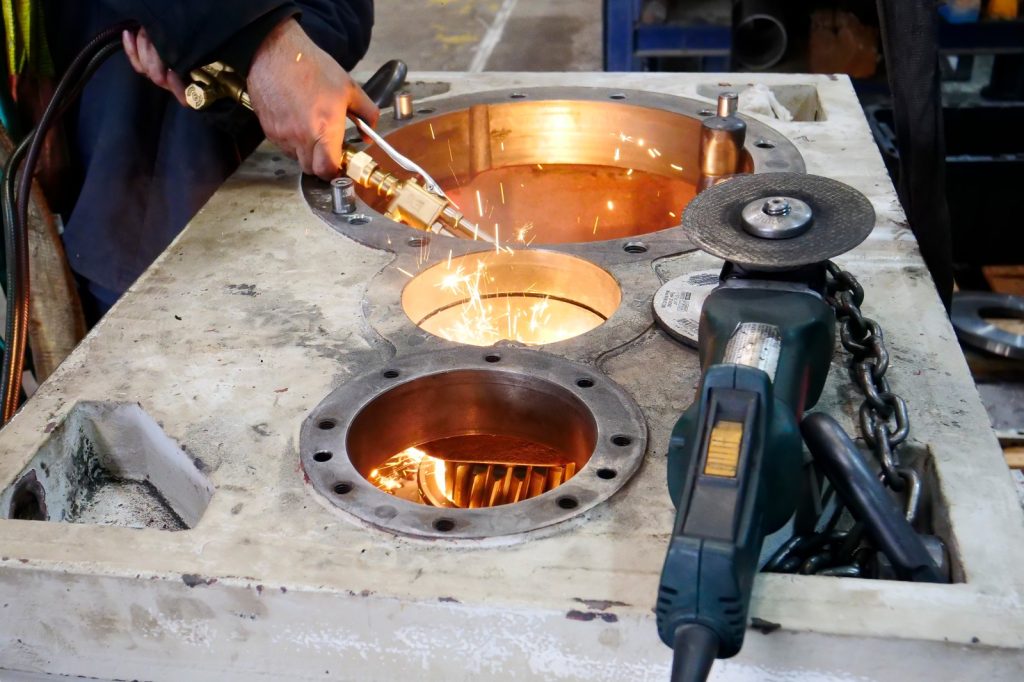Industrial gearboxes are critical components in many manufacturing and industrial processes. They are vital in transmitting power and torque from motors to machines, allowing precise control and operation. However, like any mechanical component, industrial gearboxes require regular maintenance and repair to ensure optimal performance and longevity.

In this article, we’ll explore five common industrial gearbox repair mistakes to avoid for optimal performance.
Mistake 1: Lack of Proper Lubrication
Lack of proper lubrication is one of the most common mistakes during industrial gearbox maintenance. Moving parts can experience excessive wear and tear without adequate lubrication, leading to increased friction and potential damage to the gearbox. In addition, without proper lubrication, industrial gearboxes are more susceptible to corrosion, which can cause significant long-term damage.
To ensure proper lubrication during repair, it’s essential to use the correct type of lubricant and apply it in the right quantity. Premium lubricants must be used in order for the gearbox to last a long time and perform at its peak. By controlling the speed of the machinery with industrial gearboxes, productivity can be increased, resulting in more quickly and effectively finishing construction projects. Over-lubrication can cause overheating, energy loss, and oil leaks.
To prevent such issues, following the manufacturer’s recommendations for lubrication during repair is crucial. These recommendations can include information about the type of lubricant, the correct quantity to apply, and the lubrication frequency. It’s also important to ensure the lubrication points are clean and debris-free before applying lubricant to prevent contamination. By following these guidelines and using high-quality lubricants, industrial gearboxes can perform optimally and have a longer lifespan.
Mistake 2: Improper Gear Alignment
One of the most common errors during repairs is improper gear alignment. Correct alignment of gears is vital to ensure optimal performance of the gearbox. Misalignment can lead to premature wear and tear of gears, resulting in expensive repairs.
To achieve proper gear alignment during gearbox repair, following the manufacturer’s recommendations and using specialized tools to check for correct alignment is essential. This involves checking the position of each gear tooth and the spacing between them. If misalignment is identified, it must be corrected before reassembling the gearbox.
Other issues, like excessive noise and vibration that can eventually harm the gearbox, can be avoided with proper gear alignment. A correct alignment will also improve the efficiency of the gearbox and reduce energy consumption, resulting in lower operating costs.
It’s important to note that improper gear alignment is only sometimes caused by mistakes made during a repair. Factors such as wear and tear, aging of components, and excessive loads on the gearbox can also lead to misalignment. Regular inspection and maintenance of the gearbox can help to identify and correct misalignment before it causes more significant problems. By taking the necessary steps to ensure proper gear alignment your gearbox can operate efficiently and have a longer lifespan.
Mistake 3: Overlooking Bearing Maintenance
Neglecting bearing maintenance is a common mistake that can cause severe damage to the gearbox, leading to costly repairs and downtime.
It’s essential to inspect bearings thoroughly for any signs of wear, damage, or contamination. Any worn or damaged bearings should be replaced with high-quality replacements to ensure optimal performance and longevity of the gearbox. It’s also vital to ensure that bearings are correctly installed and lubricated, as this can significantly impact their lifespan and performance.
In addition to inspecting bearings during gearbox maintenance and inspection should be part of a comprehensive maintenance plan. This can include monitoring bearing temperatures, vibration levels, and noise levels and checking for proper lubrication and alignment. Proactively maintaining and inspecting bearings can identify and correct potential issues before they cause significant damage to the gearbox.
It’s important to remember that choosing the right bearing type and size is essential for the gearbox’s best performance and longevity. Consultation with bearing manufacturers and gearbox experts can help ensure the right bearing selection for the specific application.
Mistake 4: Neglecting to Replace Seals
Seals are crucial components that help prevent leaks and contamination from entering the gearbox, ensuring its proper function and longevity.
During gearbox repair, inspecting all seals thoroughly for any signs of wear, damage, or deformation is essential. Any worn or damaged seals should be replaced with high-quality replacements to ensure proper sealing and protection of the gearbox. Ensuring that seals are correctly installed and lubricated for optimal performance is also important.
Failure to replace worn or damaged seals can lead to oil leaks, damaging the gearbox and other components. Additionally, contaminated oil can cause premature wear and tear of gears, leading to the need for costly repairs.
To avoid this mistake, it’s recommended to include seal replacement as part of regular maintenance and inspection schedules. This can help identify and replace worn or damaged seals before they cause significant damage to the gearbox.
It’s important to note that selecting the correct seal type and size is crucial for the optimal performance and longevity of the gearbox. Consultation with seal manufacturers and gearbox experts can help ensure the right seal selection for the specific application.
Mistake 5: Using Incorrect Tools or Procedures
Using incorrect tools or procedures during repair and maintenance is another common mistake that can cause significant damage and lead to costly repairs. Industrial gearboxes are complex machinery that requires specialized tools and techniques for repair.
It’s crucial to use the correct tools and procedures as the manufacturer recommends. Using incorrect tools or procedures can cause damage to the gearbox, leading to costly repairs and downtime.
Avoiding common industrial gearbox repair mistakes is essential to ensure optimal performance and longevity. Proper lubrication, gear alignment, bearing maintenance, seal replacement, and correct tools and procedures are all critical to the repair process. It’s essential to follow the manufacturer’s recommendations and use high-quality replacements to ensure optimal performance and longevity of industrial gearboxes. By avoiding these common mistakes, industrial gearboxes can function correctly and provide reliable operation for years.



Comments